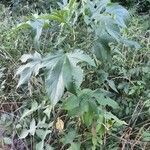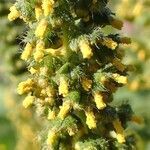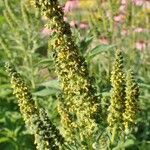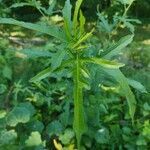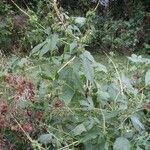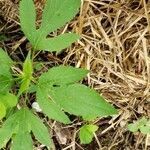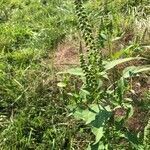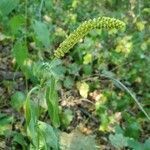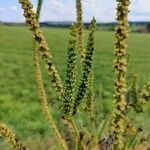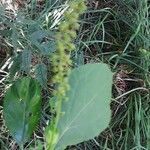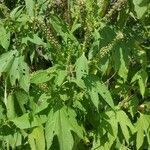Annuals, 30–150(–400+) cm. Stems erect. Leaves mostly opposite; petioles 10–30(–70+) mm; blades rounded-deltate to ovate or elliptic, 40–150(–250+) × 30–70(–200+) mm, usually some blades palmately 3(–5)-lobed, bases truncate to cuneate (sometimes decurrent onto petioles), margins usually toothed, rarely entire, abaxial and adaxial faces ± scabrellous and gland-dotted. Pistillate heads clustered, proximal to staminates; florets 1. Staminate heads: peduncles 1–3+ mm; involucres ± saucer-shaped, 2–4 mm diam., scabrellous (often with 1–3 black nerves); florets 3–25+. Burs: bodies ± pyramidal, 3–5(–7+) mm, glabrous or glabrate, spines 4–5, ± distal, ± acerose, 0.5–1 mm, tips straight (bases ± decurrent as ribs). 2n = 24, 48.
Annuals, 30-150 cm. Stems erect. Leaves mostly opposite; petiole 10-30(-70) mm; blade orbicular-deltate to ovate or elliptic, 4-15(-25) × 3-7(-20) cm, usually some palmately 3(-5)-lobed, both surfaces scaberulose and gland-dotted, base truncate to cuneate, sometimes decurrent onto petiole, margin usually toothed, rarely entire. Female capitula clustered, proximal to male; floret 1. Male capitula: peduncles 1-3 mm; involucres saucer-shaped, 2-4 mm in diam., scaberulose; florets 3-25. Bur pyramidal, 3-5(-7) mm, glabrous or glabrate, spines 4 or 5, apical, acerose, 0.5-1 mm, tips straight. Fl. Jul-Aug, fr. Sep-Nov. 2n = 24, 48.
A herb. It grows each year from seed. It grows 60 cm to 1.5 m tall. The leaves are 20 cm long and have 3 lobes divided like fingers on a hand.
